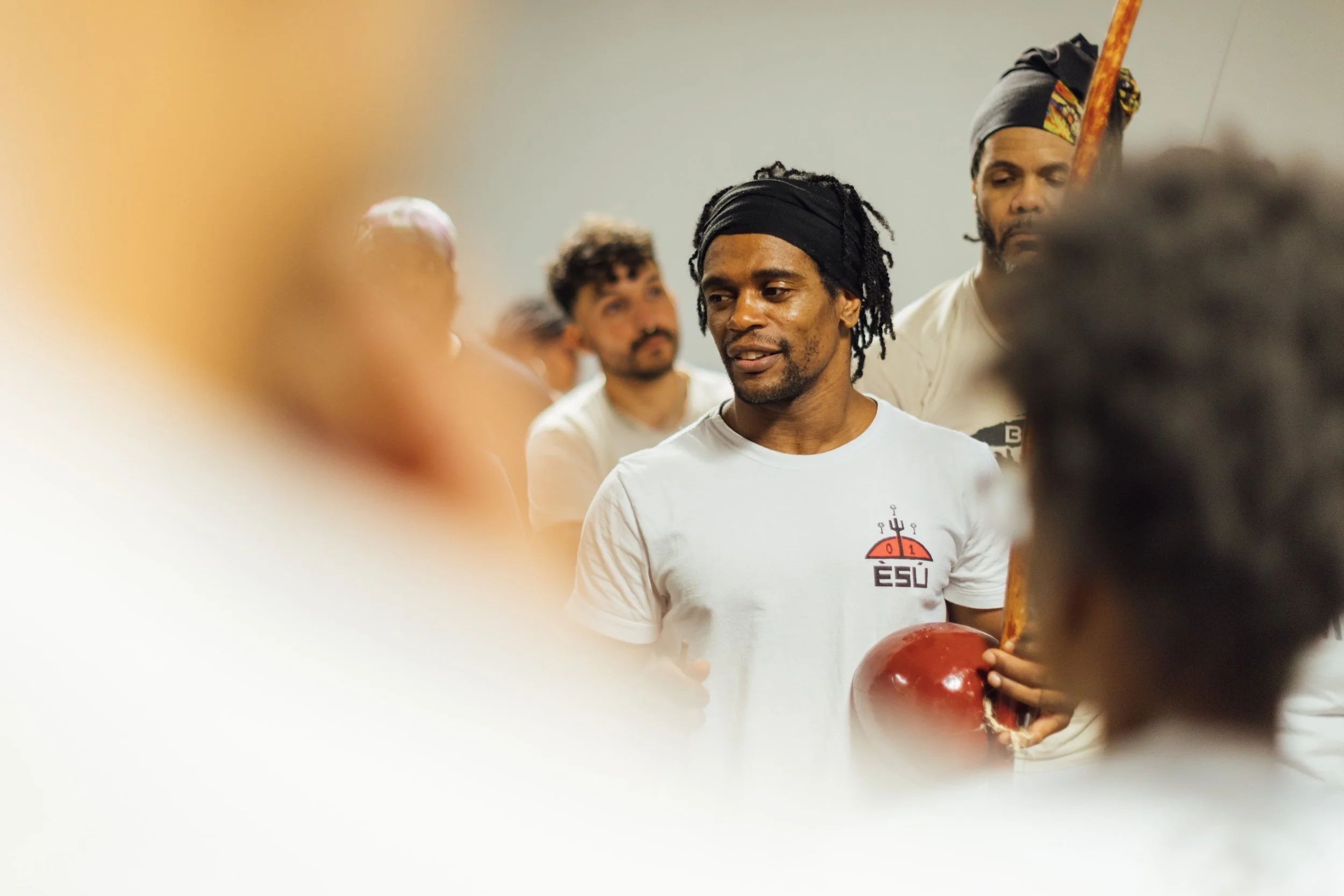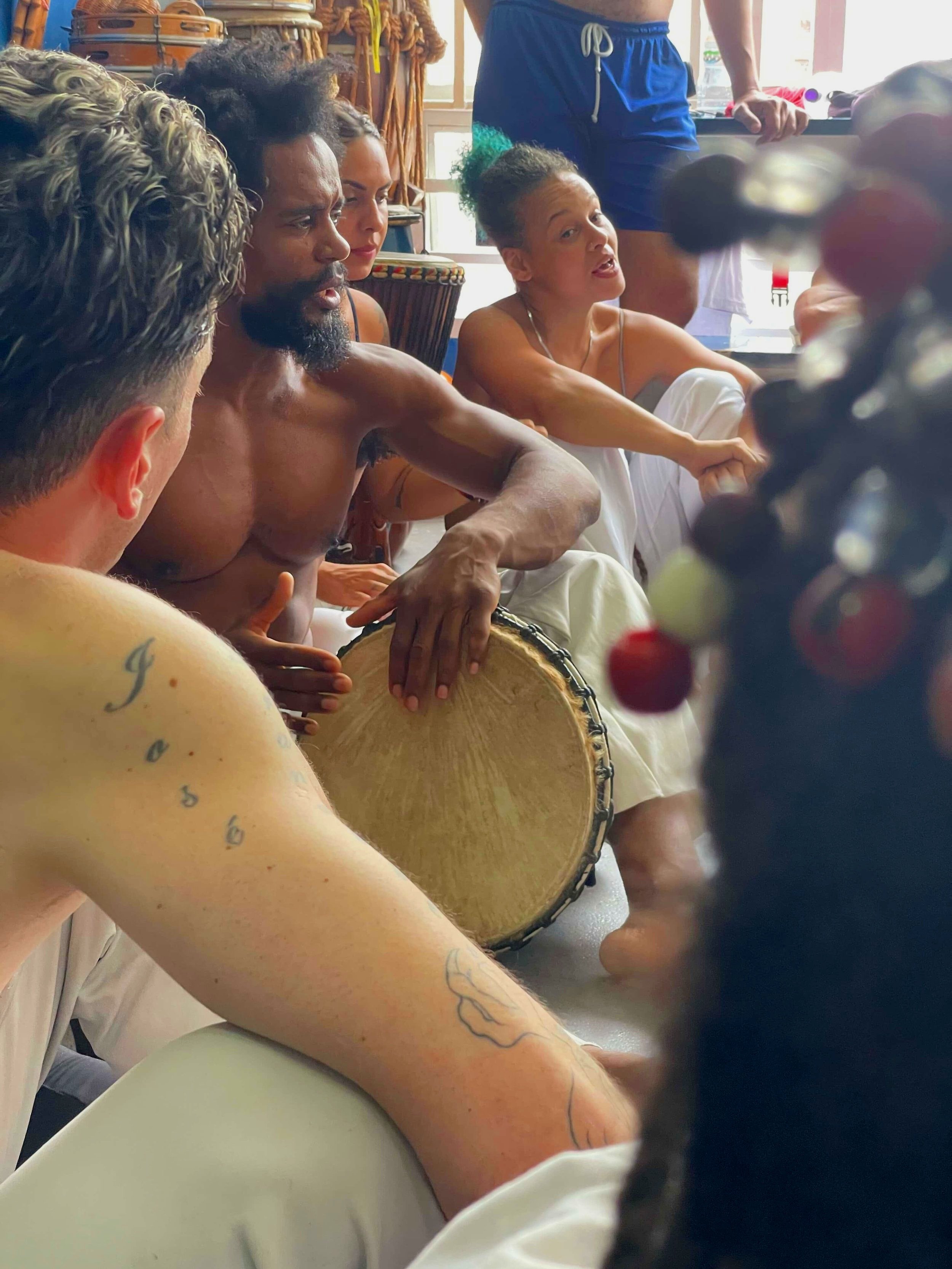
Our Teachers and Lineage

Our Teaching Philosophy
We see ourselves as ushers, not gatekeepers—guiding you to navigate the world Capoeira nation with skill, respect, and confidence. A well-rounded capoeirista can:
Flow through every style of jogo—from elegant floreios to tight jogo de dentro and full-contact combat.
Lead the roda with voice and rhythm, mastering instruments, song, and chorus.
Speak Capoeira’s language—Portuguese—and its deeper dialects of history, spirituality, and community care.
Welcome others into the circle, passing on knowledge as both player and leader.
We also see ourselves as lifelong students. Teaching, building community, and giving back to Capoeira are part of how we grow inside the art. With over a decade of training behind us, we are still learning—refining our voices, deepening our leadership, and studying with the greats, both living and ancestral. We teach not from a place of arrival, but from a deep commitment to keep learning in service of the circle.

YOUR CAPOEIRA GUIDES
-

MACAQUINHO
TEACHER
Training since 2011, Macaquinho brings a deep love of movement shaped by a lifetime of martial arts, calisthenics, and community work. He believes Capoeira is a path to liberation—physically, culturally, and spiritually. His classes are grounded, welcoming, and challenging for students of all levels. For him, teaching is a way to grow alongside his students, build lasting community, and help people move with strength and purpose at any age.
-

LOBINHO
TEACHER
With over 20 years of experience, Lobinho began his journey in Capoeira Angola and has since embraced its many expressions. He’s passionate about understanding Capoeira’s deeper roots—studying its history, music, and ancestral ties across the African diaspora. As a teacher, he leads with joy, depth, and humility. For Lobinho, teaching is a way to honor what Capoeira has given him and to pass that gift on to others.
-

GUGU QUILOMBOLA
CONTRA MESTRE
Contra Mestre Gugu Quilombola is a respected leader and guide within the Capoeira community. With over 30 years of dedication to the art, he leads the Quilombolas de Luz group, emphasizing the preservation of Capoeira's Afro-Brazilian roots. Gugu is renowned for his dynamic presence in the roda and his commitment to cultural heritage. His teachings inspire students to connect deeply with Capoeira's history, music, and movement, fostering a community grounded in tradition and growth.
CAPOEIRA FAMILY AND LINEAGE
Quilombola de Luz Capoeira (QLC)
Quilombola de Luz is a Capoeira group rooted in resistance, cultural integrity, and the preservation of Capoeira’s African and Afro-Brazilian foundations. Formed in São Paulo by Mestre Paulao after decades of deep training and visionary leadership, QLC emerged from a lineage that includes Fonte do Gravata, Captiveiro de Capoeira, and the hidden teachings of Angola passed on by great Mestres like Miguel Machado, Gato Preto, and Plínio.
For over 30 years, QLC has remained committed to honoring Capoeira’s ancestral truths—refusing to dilute its roots to appease governments, institutions, or cultural trends. Through rodas, rituals, and teaching, the group defends Capoeira as a tool for memory, liberation, and spiritual resilience.
With Mestres, Contra Mestres, and educators across Brazil and beyond, Quilombola de Luz continues to shape generations—blending technical excellence with deep cultural awareness. As a member of Capoeira Training Club, you step into that lineage: a circle that remembers, resists, and moves with purpose.


QUILOMBOLA DE LUZ MISSION
1. Rescue and appreciation of ancestry: Preserve and promote the African roots of Capoeira, connecting practitioners with the history, culture and spirituality of the peoples of the African Diaspora.
2. Integration of sister arts: Incorporate other black cultural and artistic expressions, such as dance, music, oral tradition, and spirituality, enriching the practice of Capoeira and promoting unity among cultural manifestations.
3. Strengthen the Capoeira identity: Create a space for awareness and empowerment for the Capoeira population, reinforcing pride in African heritage and recognition of its role in the construction of Brazilian and world culture.
4. Education and social transformation: Use Capoeira and its associated arts as pedagogical tools to raise social awareness, combat racism and promote a more just and inclusive society.
5. Preservation of memory and oral tradition: Keep alive the memory of Capoeira masters and ancestors, transmitting knowledge and stories from generation to generation through oral tradition and cultural traditions.
This mission goes beyond the physical practice of Capoeira, seeking personal and collective transformation, always anchored in the respect and dignity of Capoeira traditions.

Quilombola de Luz in Atlanta
Meet the Atlanta-based teachers of Quilombola de Luz—each carrying forward a lineage rooted in tradition, resistance, and community. Explore their classes, styles, and contributions to Capoeira’s living legacy.
ESTILINGUE
📍Marietta, GA
Estilingue, founder of Jogo da Ginga in Marietta, teaches family, youth, and adult classes—embodying Capoeira as a living family tradition.
TIM TIM
📍Jonesboro, GA
Tim Tim leads classes in Jonesboro under the guidance of Pele, blending Capoeira’s martial roots with cultural and community-centered practice.
TICUM
📍Georgia State University
📍Emory
Ticum leads the Georgia State University Capoeira Club and Emory, known for his powerful agility and Pan-African approach.








